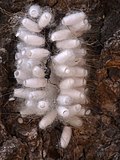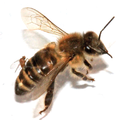Parasitoid
Parasitoids are parasites whose larvae develop inside another organism's body.[1] This usually results in the death of the host, which sets them apart from 'traditional' parasites.[2] There are twelve superfamilies of parasitic wasps which are entirely or mainly parasitoid. The largest family are the ichneumons, with over 80,000 species.
In parasitoids the adult stage is free-living: it finds the 'host' for the next generation. The female parasitoid places the eggs, on or in the body of a host. The host is food for their growth. Normal parasites use vectors as the way of getting to other hosts.
In Hymenoptera there are many variations. The distinction between the 'parasitic' and the 'traditional' hymenoptera can run very thin. In Britain there are about 6500 species of Hymenoptera – more than in any other insect order – and just one parasitoid superfamily, the Ichneumonoidea, has nearly half of them. Most workers now recognise only two families in Ichneumonoidea. These are Ichneumonidae, with over two thousand British species, and Braconidae, with nearly 1200 representatives in Britain. They are, respectively, the largest and the second largest families of British insects.[2] Only a beetle family, the Staphylinidae, is near the thousand mark. Ichneumonoids also include the largest parasitoids.
Hymenopteran parasitoids often have unique life cycles. In one family, the Trigonalidae, the female wasps deposit eggs into small pockets they cut into the edge of leaves with their ovipositor. A caterpillar chewing these leaves may swallow some of the eggs. When they get into the caterpillar's gut, they hatch and burrow through the gut wall and into the body cavity. Later they search the caterpillar's body cavity for other parasitoid larvae, and it is these they attack and feed on. Some trigonalids, once they are in a caterpillar or sawfly larva, need their host to fall prey to a social wasp. The wasp carries the caterpillar back to its nest, and there it is butchered and fed to the wasp's young. The young serve as host for the trigonalid, the eggs of which are in the butchered caterpillar.[3]
Parasitoid Media
A parasitoid wasp (Trioxys complanatus, Aphidiinae) ovipositing into the body of a spotted alfalfa aphid (Therioaphis maculata, Calaphidinae), a behaviour that is used in biological pest control[a]
A hyperparasitoid chalcidoid wasp on the cocoons of its host, a braconid wasp, itself a koinobiont parasitoid of Lepidoptera
Female phorid fly Apocephalus borealis (centre left) ovipositing into the abdomen of a worker honey bee, altering its behaviour
The head of a sessile female strepsipteran protruding (lower right) from the abdomen of its wasp host; the male (not shown) has wings
Related pages
References
Cite error: There are <ref> tags on this page, but the references will not show without a {{Reflist|group=lower-alpha}} template or a <references group="lower-alpha"/> tag.










